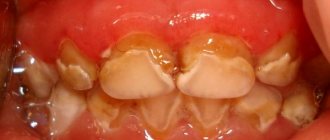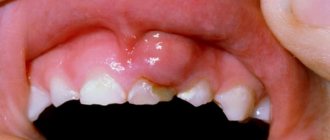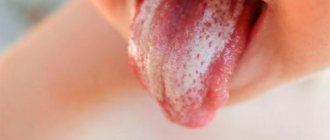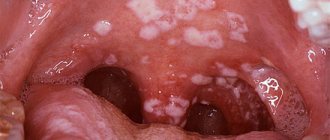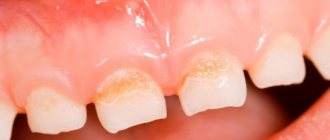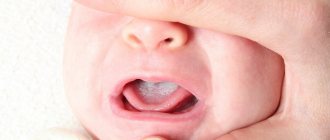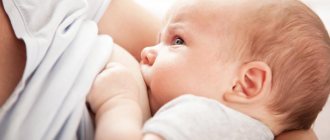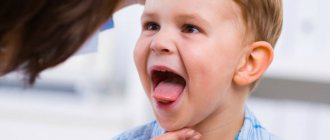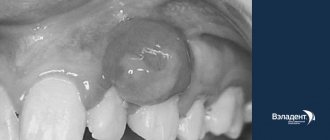Cough is one of the most common symptoms of illness in childhood.
For this reason, antitussive treatment is one of the main areas of auxiliary, symptomatic therapy and occupies one of the first places in the treatment of respiratory tract diseases in children. The main thing is to correctly determine the cause of the baby’s cough and approach the selection of medications with caution. The main document that concerns any medications used to treat newborns and children under one year of age is the instructions for medical use. When deciding to take any medications, you must be guided only by the recommendations of your attending pediatrician and the information provided in the instructions for the medication.
- Cough in children under one year old in children under one month old
- in children two months old
- in children three months old
- in children four months old
- in children at five months
A cough is a sudden explosive exhalation, which is a reflex defense mechanism designed to clear the airways of pathologically altered tracheobronchial secretions or foreign substances. In a healthy baby, the inhaled air, passing through the upper and lower respiratory tract, is warmed, moistened and cleaned, and all small foreign particles and microorganisms coming from the outside settle on the mucous membrane of the respiratory tract and are easily removed from the respiratory tract along with mucus, without causing prolonged bouts of coughing.
This is how mucociliary clearance operates - a natural process of cleansing the respiratory system, which provides mechanical, chemical, hypoallergenic and anti-infective protection of the body. The development of most respiratory tract diseases is based on impaired mucociliary clearance.i
Unfortunately, along with the incoming air, the child can also inhale various pathological microorganisms, which the immune system is not always able to neutralize, which leads to the development of various diseases and the appearance of coughing. In this case, treatment is necessary. But it is important to remember that coughing in infants is not only due to ARVI and influenza.
Among the main causes of cough reflex in infants:
- inflammatory diseases of the respiratory tract;
- influence of mechanical irritations (foreign body);
- allergic reactions;
- exposure to dry indoor air;
- congenital malformations of the respiratory system.
All these cases require a different approach to treatment.ii
Cough in children under one year of age
According to statistics and research by pediatricians, acute respiratory infections, surprisingly, are not the most common cause of cough in infants; more often, their cough occurs as a result of other, non-infectious factors. Parents of young children often encounter unproductive coughing, which is due to the increased viscosity of bronchial secretions. The thing is that even in a healthy small child there is a process of disruption of the “sliding” of sputum in the respiratory tract, insufficient activity of the ciliated epithelium of the bronchi and the contractile apparatus.
In other words, a newborn baby does not yet know how to cough properly, as adults do. Natural mucus can stagnate in the respiratory tract and over time cause attacks similar to a barking infectious cough. Underdevelopment of the respiratory muscles in a child sometimes leads to the fact that it becomes difficult to determine what is bothering him, whether he is coughing or simply crying. And at this time, it is very important for parents not to panic and not to start treating the child with the first antitussive drugs available, offering him syrups, tablets and inhalations without consulting a doctor.
Cough in a 1 month old baby
The respiratory system of newborn children is distinguished by the presence of a number of age-related characteristics. They can lead to the development of complications that are typical for the youngest. For example, the mucous membrane of the respiratory system in infants is supplied with blood more abundantly than in older children. This can lead to swelling and, as a result, difficulty in nasal breathing.
In addition, newborn babies have physiologically narrow nasal passages, which makes it difficult for them to breathe. With a viral or bacterial runny nose, a child who, due to his age, does not yet know how to blow his nose and breathe through his mouth, begins to literally choke on mucus. This is how a cough appears, which can manifest itself in the form of crying - in this way the child tries to get rid of discomfort and clear the nasal passages.
Also, in newborn children, the trachea and bronchi are anatomically narrow. For this reason, any inflammation in the respiratory organs can lead to intermittent air supply to the alveoli of the lungs, which can lead to respiratory failure.
Only a doctor can determine the exact cause of cough in a one-month-old baby, so it is better to avoid self-medication and if the child’s behavior and the nature of his crying change, immediately contact a specialist.
Cough in a 2 month old baby
Breathing in children in the first months of life, including infants at 2 months, occurs through contraction of the diaphragm. This is the muscle that separates the chest cavity from the abdominal cavity. Older children and adults also “help” the intercostal muscles and abdominal muscles in the breathing process, while an infant uses only the diaphragm.
As a result, such breathing often leads to the fact that any diseases and dysfunctions of the gastrointestinal tract also lead to problems with the functioning of the respiratory system. Few parents know that a baby can cough not only due to infections, but also when conditions and diseases such as colic, increased gas formation and constipation appear.
If you, without following the advice of modern pediatricians, swaddle your newborn tightly and thereby limit the mobility of his chest and diaphragm, for this reason the child may also begin to cough.
Cough in a 3 month old baby
Allergies are also among the causes of cough reflex manifestations in 3-month-old children. In young children, the intestinal walls are extremely permeable, which increases the risk of developing allergic reactions, especially food ones. Most often, food products consumed by a nursing mother become provocateurs. Moreover, allergies can be caused not only by such well-known allergens as chocolate, citrus fruits, red fish, strawberries, but also by any other products that at first glance may be completely harmless. It's all about the individual sensitivity of the child's body. A child can also have allergic reactions to the mother’s eau de parfum or her cosmetics.
The risk of developing allergies is high in those children whose parents suffer from asthma, atopic dermatitis and themselves often experience allergic rhinitis. If both parents suffer from allergic diseases, their child has a 50-80% chance of developing allergies. It is not necessary that the allergy will manifest itself before the age of one, but still, when a newborn develops a cough, it is necessary to take this factor into account.
To identify the causes of allergies in a baby, the help of a pediatrician and special diagnostics are necessary.
Cough in a 4 month old baby
An unhealthy microclimate in the room where a child lives can also activate the cough reflex. The optimal air temperature in a newborn's room is 22-24 0C. Sufficient air humidity is also very important. If the air is too dry, the mucous membranes in the child’s respiratory organs dry out and begin to secrete a special secretion to protect themselves, which can lead to a runny nose and nasal congestion. In this case, there may be no discharge from the nose; the child simply “grunts” his nose often, trying to get rid of the discomfort. As already mentioned, the nasal passages of a newborn are narrow and short, so nasal congestion and swelling in young children create much more discomfort than in adults. The formation of dry crusts in the nose further complicates the situation.
In dry air there is a deficiency of oxygen, which is necessary for the functioning of the body. Due to lack of oxygen, infants become more irritable, are capricious and sleep poorly, cough and thereby lead parents to think that infectious diseases are to blame. Dry mucous membranes of the nasopharynx in the absence of sufficiently humid air actually cease to trap pathogenic microorganisms, which penetrate the child’s body and increase the risk of developing ARVI and other diseases.
To prevent coughing from dry air in young children, it is necessary to maintain room humidity at 60-70% using humidifiers.
Cough in a 5 month old baby
A cough can also bother your baby due to his intolerance to formula milk. Everyone knows that the most balanced product for babies is breast milk, from which the child receives the optimal nutrients for his body in the quantities he needs. But in some cases it is impossible to do without formula milk. Adapted milk formulas are produced in accordance with the requirements and age-related, physiological and biochemical characteristics of the baby’s body. Today you can start feeding your child with artificial formula from the first days of his life, changing them as he grows older.
However, unfortunately, even the highest quality artificial food for babies does not contain antibodies that are transmitted to him from the mother and protect him from diseases, including allergies. On average, just 40 ml of formula contains the same amount of protein, which causes allergies, as almost 40 thousand liters of breast milk. Accordingly, in many cases, when consuming infant formula, the risk of pathological reactions and coughing in infants significantly increases. Moreover, a situation where a baby coughs periodically may be the only symptom that a certain milk formula is not suitable for the child.
Physiological causes of regurgitation
- short esophagus or ball-shaped esophagus;
- the esophagus becomes wider in the upper part (has the shape of a funnel);
- the esophagus is narrowed (this process is normal, according to physiology);
- The gastric sphincter is underdeveloped. This is a temporary phenomenon (due to age).
The muscular corset of the stomach is still weak, and the mucous membranes are quite sensitive. That is why, when food enters the stomach, its bottom begins to produce contractile movements. As the pressure level increases, food makes its way back into the oral cavity from the esophagus.
How to help with a cough in a baby without fever
If a child coughs frequently and this prevents him from breathing and eating, the help of a pediatrician is needed. In case of rare attacks, it is necessary to try to find the cause of the cough reflex from the above and provide assistance to the baby:
- take the baby in your arms and calm him down;
- free his chest from tight clothing;
- give the child warm water;
- provide access to fresh air in the room, take a walk with your child outside;
- If there is a large amount of mucus and crusts in the child’s nose, they must be carefully removed with a soft cloth and an aspirator.
A nursing mother should reconsider her diet, try to do wet cleaning in the baby’s room more often, not turn on the batteries at full power during the cold season, and use a humidifier.
If your baby gets sick with ARVI, it is necessary to start antiviral therapy.
What is regurgitation?
Regurgitation in infants is considered to be the spontaneous release of a small amount of just eaten food (milk or formula) into the baby’s mouth from the stomach.
Content:
1. Types of regurgitation |
00:56 (in video) 2. Physiological causes of regurgitation | 01:40 (in video) 3. Functional causes of regurgitation | 02:43 (in video) 4. Permissible frequency of regurgitation 05:13 (in video) 5. Until what age can regurgitation continue | 05:47 (in video) 6. Is it necessary to feed the baby after spitting up | 06:23 (in video) 7. Actions when spitting up | 07:11 (in video) 8. Congenital pathologies of the gastrointestinal tract, as a cause of regurgitation 9. Actions to prevent regurgitation Online consultation with a pediatrician (Breastfeeding Specialist)
Online consultation
During the consultation, you will be able to voice your problem, the doctor will clarify the situation, interpret the tests, answer your questions and give the necessary recommendations.
What to do if your baby is coughing from colds and flu
One of the drugs that can be used to treat very young children, including newborns and premature babies with a gestational age of less than 34 weeks, is the antiviral drug VIFERON.
The drug VIFERON has a wide spectrum of antiviral activity. Alpha-2b interferon, which is part of the drug, was created on the basis of modern technologies. Antiviral properties allow it to block the reproduction of the virus, and the immunomodulatory effect helps restore immunity. The drug was developed as a result of fundamental research in the field of immunology, which proved that in the presence of antioxidants (vitamins C, E and others), the antiviral effect of interferon is enhanced.
For the treatment of children under one year old, the drug VIFERON is used in the form of suppositories and gel. The ointment is used to treat children over 1 year of age.
Children under 7 years old, incl. newborns and premature infants with a gestational age of more than 34 weeks are prescribed VIFERON Suppositories (suppositories) 150,000 IU, 1 suppository 2 times a day after 12 hours every day for 5 days. According to clinical indications, therapy can be continued. The break between courses is 5 days.
Premature newborns with a gestational age of less than 34 weeks are recommended to use the drug VIFERON 150,000 IU, 1 suppository 3 times a day after 8 hours every day for 5 days.
The article “Acute respiratory infections in children: optimization of treatment tactics” describes the results of a study of the use of the drug VIFERON in the treatment of ARVI and influenza.1 In the group consisting of children of different ages who received the drug, positive dynamics were observed: body temperature tended to normal, symptoms decreased intoxication, the intensity decreased until the cessation of catarrhal symptoms (cough, runny nose) and respiratory syndrome (difficulty breathing) on average two days earlier than in the control group. For children undergoing treatment in a hospital, nosocomial infection becomes a frequent problem and threat to delay treatment and complications of the underlying disease. It is important that among children who received VIFERON, infection occurred half as often.
Depending on the pediatrician’s recommendations, for the treatment of ARVI, it is necessary to apply a strip of VIFERON Gel approximately 0.5 cm long to the nasal mucosa 3-5 times a day for 5 days. Before this, it is better to rinse the mucous membrane with saline solution. In order to protect a child from ARVI, it is necessary to apply a strip of gel approximately 0.5 cm long to the nasal mucosa 2 times a day as a preventive measure. Course duration is 2-4 weeks.
Reference and information material
Author of the article
Gerasimenko Igor Olegovich
General doctor
Sources:
- Nikolaeva S.V., Khlypovka Yu.N., Gorelov A.V. Acute respiratory infections in children: optimization of treatment tactics. //RMJ 2019; 1(*): pp.1-5.
i https://cyberleninka.ru/
ii https://www.rmj.ru/
Loading...
Take other surveys
Do I need to feed my baby after spitting up?
- If the baby has eaten a long time ago, the milk/formula has almost been digested; if the body position changes, the baby may still burp. This is not a reason for additional feeding.
- If regurgitation occurs after feeding, this is a sign of overeating. It’s also not worth feeding.
- If the baby spits up profusely, this is a reason to discuss this issue with the pediatrician. We also don’t supplement feeding.
- If regurgitation is minimal, then you can feed as usual.
Taking into account the physiology of children, it is not possible to find a clear connection between feedings and regurgitation.
Reasons to see a doctor
In case of true hypersalivation, drugs that have an anticholinergic effect are prescribed. These include:
Taking such medications has a number of side effects that can be an order of magnitude more serious than excessive salivation. Surgery and radiation are also dangerous for abnormalities such as caries or facial asymmetry. Any decisions regarding the treatment of a problem should be made carefully, choosing methods based on their feasibility and individual characteristics.
Excessive salivation can cause dysarthria in an older child - a problem with pronunciation. Speech becomes slurred and unintelligible. This in turn slows down the pace of development, which negatively affects his socialization. In such cases, qualified speech therapy massage may be needed. During this period, the baby should drink more water in order to restore fluid loss in the body. Whatever causes the drooling problem, it is important not to leave it to chance.
Forecast
With timely seeking help and competent therapy, the prognosis is favorable. In the case of a prolonged course of children's non-temperature cough (more than 3 weeks), complications may develop or chronicity of pathological processes in the upper respiratory tract. In children, a prolonged cough is more severe than in adults, since the child’s mucous membrane is less adapted to irritants. Lack of treatment can lead to the development of dangerous conditions such as bronchial asthma, bronchitis and pneumonia.
Types of disease
A child's cough without fever may vary in quality and duration. Depending on the presence or absence of exudate, non-temperature cough can be dry or wet. A dry cough is sometimes accompanied by wheezing and is more often seen with allergic reactions. A wet cough is characterized by the discharge of sputum; it appears with colds, bronchitis, and tuberculosis.
According to the nature of the attacks and their duration, children's cough without fever is divided into:
- paroxysmal cough: the child chokes and complains of severe spasms in the throat;
- rare and short-term cough: normal variant; occurs in response to the presence of a provoking factor immediately at the time of a coughing attack (difference in humidity, temperature, presence of an allergen, mold or dust in the immediate vicinity);
- a prolonged cough without fever does not go away for more than a month and indicates the presence of a strong inflammatory process in the body: asthma, whooping cough, tuberculosis, pleurisy (in the latter case, the cough will be dry);
- deep cough is a symptom of allergies, respiratory pathologies and tumor processes;
- a purulent cough indicates a severe bacterial infection.
A non-temperature cough with painful sensations in the throat before, during and after an attack indicates damage to the mucous membrane or the development of local infectious and inflammatory processes of the nasopharynx: sore throat, pharyngitis, laryngitis.
Prevention
The main prevention of children's cough without fever is to follow general recommendations for maintaining the health of the child's respiratory tract. You can add the following:
- Teach your child to use nasal breathing while walking in the fresh air;
- if the mucous membrane of the throat is irritated, let the child drink a lot of warm liquid;
- maintain a sufficient level of humidity in the apartment, especially in the nursery, where the child spends a significant part of the day;
- at the first sign of cough as a symptom, convince the child to maintain a vocal regime: try not to scream and talk as little as possible;
- Make sure your child's hands, feet and head are always warm.
Helping your baby with excessive salivation
A continuous stream of drool in an infant causes discomfort to both the baby and the parents. The result of excessive drooling can be not only constantly wet clothes and a bad mood, but also irritation in the chin and chest (more details in the article: irritation from drooling on the chin of a baby). A rash like this, which appears as a result of endlessly flowing drool, causes far from pleasant sensations and additional inconvenience. Plus, a large volume of saliva secreted can provoke a cough in the baby.
Using teethers and special gels for gums will relieve itching in the mouth and soothe the baby.
It is possible to minimize all the ensuing consequences through proper care, which includes:
- Using bibs. They have been used for a very long time and, due to the presence of a liner made of waterproof materials, they perfectly protect the baby’s chest from constant exposure to moisture. It wouldn’t hurt to include them in the list of things that need to be purchased before the baby is born.
- Buying a pacifier. In the modern world, many mothers are trying to give up pacifiers. However, it can be very useful, because it makes it much easier for the baby to swallow drool.
- Purchasing teethers. Such inventions are aimed at reducing itching of the gums. At the same time, they perfectly absorb excess saliva. It is important to regularly put them in the wash and rinse them thoroughly.
- Using face creams containing vitamins A and E. Lubricating irritated areas with them will reduce discomfort.
- Placing the baby on his tummy. Since newborn babies lie on their backs almost all the time, drool accumulates, as it is difficult for it to flow out of the mouth. Placing the baby on your stomach is an excellent solution to this problem.
- Use of cooling and anesthetic gels. They will relieve itching in the gums, which in turn will lead to a decrease in irritation, and therefore a decrease in saliva production.
Congenital pathologies of the gastrointestinal tract as a cause of regurgitation
- Hiatal hernia. This is a congenital defect expressed in the underdevelopment of the structures of the diaphragm. Regurgitation begins within a couple of weeks after birth, lasts a long time, occurs immediately after feeding, the baby stops gaining weight or even loses weight. To identify this diagnosis, an x-ray examination is performed.
- Relaxation of the cardia (or chalasia of the sphincter that separates the esophagus and stomach). If it is not completely closed, then milk is released unchanged from the stomach into the esophagus. This type of regurgitation appears in the first days after birth and can be severe, especially if the baby has not burped up air. The child is lethargic, sucks poorly, sleep is disturbed, and there is no weight gain. X-ray examination can confirm the diagnosis.
- short esophagus (congenital anomaly) - the stomach is located above the diaphragm due to the fact that the esophagus does not correspond to the size of the chest.
If a mother is alarmed by the baby’s regurgitation and at least one of these signs is present, this is a reason to consult a doctor immediately.
- the child spits up often and a lot;
- bile and blood are present;
- regurgitation began after six months or did not go away by this time;
- poor weight gain, lethargy, rare urination.
- restless behavior
- increase in body temperature,
- skin rashes.
The formation of a mechanism that prevents regurgitation begins in the last 3 months of the mother’s pregnancy and continues after the birth of the baby.
Reflux is a mechanism of regurgitation, antireflux is the opposite phenomenon.
The antireflux mechanism is a complex system that can be damaged by various factors. Often this damage is observed in premature babies or children with developmental delays, as well as during difficult pregnancy, cesarean section, difficult childbirth, hypoxia and increased intracranial pressure.
If these factors are present, in addition to regurgitation, the baby will have signs of a nervous system disorder: mild excitability or vice versa, the child will be very lethargic, sleep will be disturbed, there will be tremor of the arms and legs, the presence of hypertonicity and hypotonicity.
As a rule, to determine the cause of regurgitation and prescribe appropriate treatment, ultrasound, x-rays, and computed tomography of the abdominal cavity are used.
Preserving the health of the child is the main task of parents. If your baby’s behavior, sleep, or health have worsened and you are concerned, consult a doctor. Consulting a specialist will never be superfluous. There are a lot of reasons for regurgitation, as a rule, they are all due to physiology, but only mom and dad are able to notice in time that something is going wrong and correct the situation in time without harm to the health of the little person.
Treatment of children's cough without fever
If you suspect a pathological nature of a child’s cough, you should contact a pediatrician or otolaryngologist. Timely treatment will allow for competent cough therapy and avoid complications.
The therapeutic regimen is based on an integrated approach: some of the measures are aimed at relieving coughing, and some are aimed at eliminating its root cause.
Drug therapy includes several groups of drugs:
- antitussives (weakening the cough reflex);
- mucolytic;
- antiallergic;
- antimycotics;
- antibiotics;
- antiviral.
Additionally, a course of inhalations with medicinal solutions (via a nebulizer) may be prescribed. General recommendations include sufficient indoor air humidity, quiet walks, and drinking regime (warm drinks).
Since cough most often acts as a symptom of the underlying pathology, the success of getting rid of it depends on the success of treating the disease that became the root cause. The treatment plan is prescribed by a specialist.
Sources
The following materials were used to create this article:
- G. A. Samsygina. Cough in children. Clinical manual - 2nd ed., revised. and additional - Moscow: GEOTAR-Media, 2021. - 192 p.: ill. — (Series “Library of a Medical Specialist”).
- Glukhov S.A. Artificial cough // Great Medical Encyclopedia: in 30 volumes / ch. ed. B.V. Petrovsky. — 3rd ed. - M.: Soviet Encyclopedia, 1979. - T. 10: Kabakov - Coalescence. — 528 p.: ill.
- I. G. Bereznyakov. Mechanisms of cough // News of medicine and pharmacy, December 2005, No. 20-22 (180-182).
- Nikitin V. A., Marks S. I., Tolstykh E. M., Vasilyeva L. V. Clinical variants of the cough reflex and their correction / Voronezh State Medical University named after N. N. Burdenko. // M.: Russian Respiratory Society (RRO), 2021. Scientific and practical journal “Pulmonology”, No. 26 (2).
Symptoms
To understand why the baby is coughing, it is necessary to conduct an examination. The doctor pays attention not only to the information received from the parents, but also determines the objective signs inherent in each case. They become the basis for a preliminary diagnosis.
Physiological phenomena
If, apart from drooling and a rare cough, nothing is detected, the child is active, eats well and is not capricious, then all worries are in vain - the reason, most likely, lies in the physiological characteristics of childhood. A similar conclusion can be made when signs of an erupting tooth are identified: redness and swelling of the gums, the child’s desire to take surrounding objects into his mouth and “scratch” the disturbing area with them. Sometimes the temperature even rises slightly (no higher than 38 degrees), but the general well-being does not suffer at all.
Pathology
Identification of more serious symptoms, on the contrary, creates confidence in the pathological origin of the phenomenon in question. If, along with cough and drooling, there is fever and intoxication, the baby has a stuffy nose, snot, and upon examination the throat is red, then a respiratory infection can easily be assumed. For example, other symptoms will indicate a tracheoesophageal fistula in an infant:
- Cough with every feeding.
- Discharge of foamy mucus from nose and mouth.
- Difficulty breathing.
- Blueness of the skin.
Any pathology that a pediatrician has to deal with is accompanied by certain symptoms, and some of them are specific to a certain extent. Therefore, it will not be difficult for a specialist to find out whether a child’s cough is associated with drooling or not. If there is insufficient information based on the results of a clinical examination, then additional methods are used. But one way or another, the source of the cough will definitely be determined by the doctor.
source


